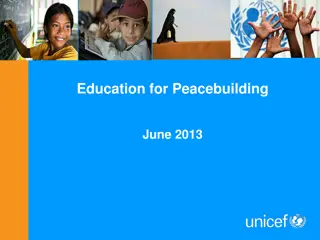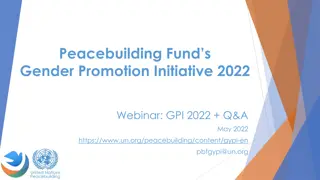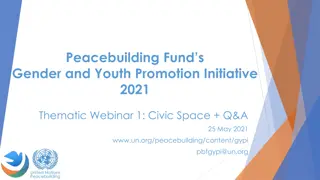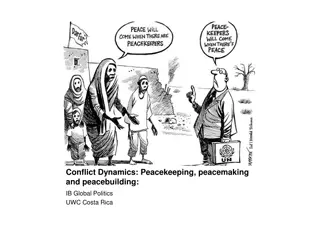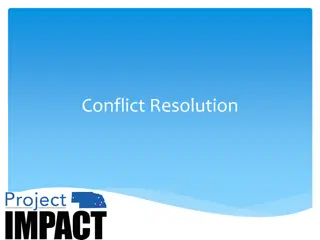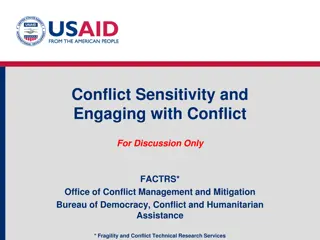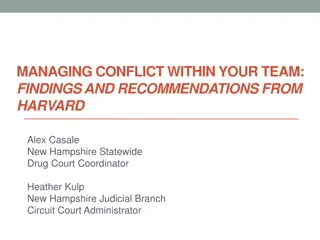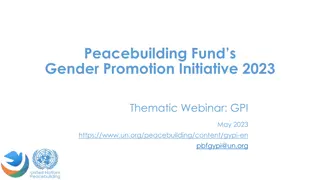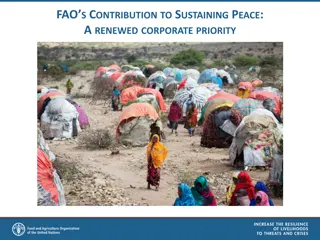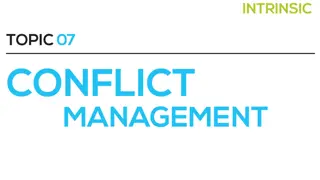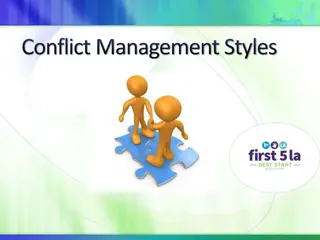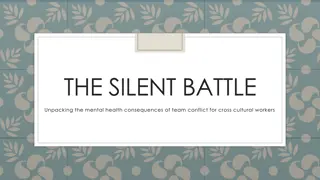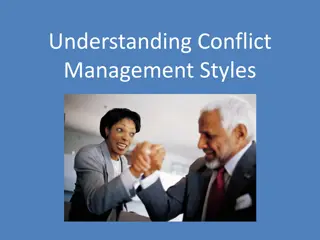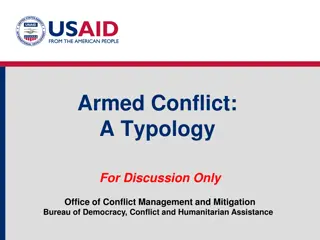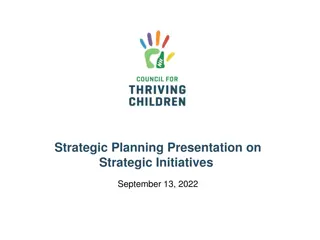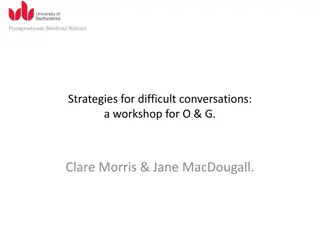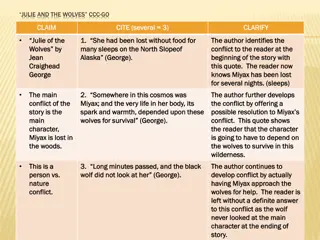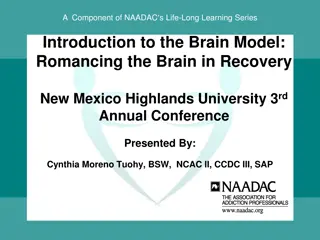Enhancing Peacebuilding Initiatives Through Strategic Conflict Analysis
Explore the Peacebuilding Funds Gender and Youth Promotion Initiative 2021, focusing on transitioning from concept notes to project implementation. Learn about conflict analysis, sensitivity, theory of change, and results frameworks to drive impactful interventions. The webinars and timelines offer valuable insights on developing effective peacebuilding strategies.
Download Presentation

Please find below an Image/Link to download the presentation.
The content on the website is provided AS IS for your information and personal use only. It may not be sold, licensed, or shared on other websites without obtaining consent from the author. Download presentation by click this link. If you encounter any issues during the download, it is possible that the publisher has removed the file from their server.
E N D
Presentation Transcript
Peacebuilding Funds Gender and Youth Promotion Initiative 2021 Thematic Webinar 3: From a concept note to a project + Q&A 9 September 2021 www.un.org/peacebuilding/content/gypi pbfgypi@un.org
Overview GYPI Timeline Stage II Conflict Analysis Conflict Sensitivity M&E Results frameworks Project Analysis - Theory of Change Q&A
GYPI 2021 Timeline Stage II Congratulations on your proposal making it to GYPI stage II! Timeline: 17 September COB: Deadline for PSEA Documents for CSO Deadline for draft proposals for feedback (optional) - Please submit by email to pbfgypi@un.org, feedback will be sent 2 weeks later. 22 October 23:59 (EST) Deadline for submission of full project proposals Please submit by email to pbfgypi@un.org, late submissions will not be accepted.
1. The journey What is the difference between the current situation and the desired change? Current situation Key conflict drivers and stakeholder analysis What are the peacebuilding needs? What is the strategic space for a peacebuilding intervention? Desired Change Conflict Sensitivity Theory of Change Conflict Analysis Results Frameworks Underlying Assumptions Conflict Drivers Monitoring and Evaluation
2. Conflict Analysis too general Just a list of factors too detailed Basis for quality programming where to deliver impacts? How to deliver impacts? Starting Point Conflict Analysis Does not justify the planned activities not up- to-date Conflict Analysis skewed or limited
2. Conflict Analysis A good conflict analysis contains: High level/national level conflict analysis: Contains conflict factors and indexes about characteristics and places where the intervention is to take place 1 Project-specific analysis: Presents information pertinent specifically to the project. (ep thematic focus, region disaggregated data, differentiated dynamics, etc.) 2 Key stakeholder analysis: Understands the constellation of actors and most important stakeholders, those interested in continuing the conflict and those with the power to finish them. 3 4 Addresses biases: It is impossible to avoid all biases, but the analysis should prioritize the gender and youth perspectives and from other marginalized groups Concise and structured drafting: Presents information on a prioritized manner. The reader should be able to directly identify the priorities and the essential conflict drivers. 5
2.1. Conflict Sensitivity Conflict Sensitivity Do No Harm Risk Management An organization s ability to: Understand the context where it operates Understand the interaction between the [planned] intervention and the context Act based on this understanding to minimize negative effects and maximize positive effects on conflicts (conflict drivers). A way in which humanitarian and international development assistance allocated in a conflict situation can be channeled so that instead of aggravating/exacerbating the conflict, it enables the local population to disengage from the fighting and set up conflict resolution systems to address conflict drivers in their society. Iterative activity that helps organizations develop strategy, achieve goals and make informed decisions. Risk management takes into consideration the internal and external context of the organization, including human behavior and cultural factors. What can go wrong? How can we solve it? (CDA) (ISO 31000:2018 Risk Management) (OECD/DAC)
2.1. Conflict Sensitivity Monitoring and Evaluation Project Life cycle Design Implementation Mitigating security risks Mitigating beneficiaries' risks Mitigating risks of corruption fund misusage Stakeholder coordination Updated the conflict analysis Impact tracking tools Project adaptation new data Including conflict sensitive questions on evaluations Conflict analysis Risks Analysis Reflections on: Recruitment Beneficiaries' selection Implementing partners Local structures Potential spoilers
Gender- and Youth-Sensitive Conflict Analysis Include a comprehensive gender- and youth-sensitive conflict analysis: highlighting the gender and age dynamics at stake as part of the context, causes, dynamics and resolution of conflict. analyzing how women, men, girls and boys experience conflict differently and how their situation, roles and responsibilities have both been impacted by the conflict, involved in the conflict and contributed to its resolution. Ensure that the term gender does not equate women, and that the term youth does not equate with young men . Gender intersects with age, class, race, sexual orientation and other identities, (re)producing a range of masculinities and femininities. It s therefore important to pay attention to variations in the specific roles, experiences and needs of different women, men, girls and boys. Consider gender sensitivity beyond women-men dynamics and age sensitivity beyond the youth-adult divide. Be as specific as possible and acknowledge the diversity of the identity and conflict- and peacebuilding roles of women, men, girls and boys in a specific context (rural/urban, ethnicity, political affiliations, socio-economic diversity, age, etc.) A participatory approach should be used, ensuring the meaningful engagement of key stakeholders such as women, youth, vulnerable groups, youth and/or women s organizations, etc.
Conflict Analysis examples PBF/IRF-312: Improving psychosocial support and mental health care for conflict affected youth in Somalia: a socially-inclusive integrated approach for peace building by WHO, UNICEF & IOM PBF/IRF-259: Participation des jeunes la gestion durable des ressources foresti res pour le renforcement de la coh sion sociale dans la r gion Ouest de la C te d Ivoire UNDP&IOM PBF/IRF-381: MOVEO - J venes en acci n: hacia la diversidad sin violencia forjando alianzas para la construcci n de paz y justicia en El Salvador UNODC & IOM PBF/IRF-404: Promouvoir la participation des femmes la consolidation de la paix gr ce aux paillottes de paix by Fund for Congolese Women PBF/IRF-400: Allanando el camino": Women and LGBT people paving a path from justice and memory toward sustaining peace in Colombia by Christian Aid Ireland
3. Monitoring and Evaluation Monitoring Continuous process of systematic data collection that relates a selection of indicators to allow those implementors and main stakeholders to have information on the use of the allocated funds, the extent of the progress made, the chances of achievement set goals and obstacles to improving performance. Evaluation Process by which one determines the interest, value or usefulness of an activity, policy or program. This is a systematic and objective assessment of a project, program or policy, underway or completed, its design, implementation and results. The objective is to determine the relevance and achievement of objectives, development efficiency, effectiveness, impact and sustainability. An evaluation must provide credible and useful information, allowing the lessons of experience to be incorporated into the decision- making process of both beneficiaries and donors.
3. Monitoring and Evaluation PBF Expectations in terms of M&E 1. It s the main responsibility of the fund recipients 2. Solid Results Frameworks 3. Timely baseline data collection 4. Diverse data sources 5. Data utilization: Adaptation and learning 6. Documenting changes 7. External independent evaluation 8. Budgeting for M&E: 5%-7%
3. Monitoring and Evaluation The plan Results 1 M&E Responsibilities Indicators 2 Defining indicators M&E Budgeting Data sources 3 Data collection frequency Data analysis
Gender and Youth Considerations for M&E Monitoring and evaluations need to be gender- and age-sensitive. It is important to ensure that the evaluators have gender- and age-expertise and that the ToR have detailed gender- and age-considerations All people-related data and indicators need to be disaggregated by gender and age. In case this is not possible, a justification needs to be provided Working with beneficiaries and key stakeholders such as women and youth in designing the M&E framework can help identifying what needs to be measured and heightens the project s transparency and accountability Monitoring should include specific sources of gender- and youth-relevant information.
4. Theory of Change Because theories of change explain why an action is assumed to produce a certain change, they inform the very initial steps of conceptualizing an approach at the design stage. A good rule of thumb for assessing a theory of change is to determine whether a given formulation explains why a change is expected to happen or if it describes how it will happen. If the statement explains how and not why , it is not making explicit the embedded assumptions that are driving programmatic choices. Instead, formulations that explain how change is expected to work are referred to as logic models because they summarize each step in a project s activities and examine how they are logically connected through time to produce the desired change.
4. Theory of Change Theories of change benefit from research and studies that provide evidence that a given approach is likely to produce the desired change. Making assumptions explicit Testing assumptions through implementation Project effectiveness Increased knowledge base Improve future programming
4. Theory of Change Supporting evidence Programmatic Approach Assumptions Before determining which approach is best for any given project, teams should examine the range of programming options and associated evidence in this manner to understand how the various assumptions underpinning the different approaches play out in their specific contexts.
Gender- and Youth-Responsive ToC The Theory of Change should clearly articulate the causal link chain that will lead to greater gender equality and/or youth empowerment and improve peacebuilding outcomes Avoid making assumptions on behalf of the beneficiaries, about what you (or the team) think should constitute meaningful change Develop the ToC in collaboration with key stakeholders, especially women and youth, to ensure that project outcomes reflects the desired change If time constraints make this infeasible, carry out a validation exercise to confirm that outcomes are gender- and youth- responsive prior to finalizing the project proposal.
Gender sensitive ToC Example Assumptions: To improve Sudan s peace and political processes and contribute to the acceptance of inclusivity among communities, The activities will increase the receptivity of the male-dominated political processes to the added value of women and young women as they see the benefits of their increased participation and leadership. government young women and established women leaders are connected to one another in South Kordofan, West Gedaref, representatives, emerging Young men will be eager to engage with the project and, with women and young women leaders, as the project has been designed to incorporate their interests and recognizing that that both young men and young women experience the violence of exclusion. Kordofan, and The project management team will be able to build on our strong, credible, and trustworthy relationships to identify and mobilize established women and emerging young women leaders. and avenues for empowerment, feedback, and collaboration through intersectional trust building and communities in those peripheral states and national decision makers amplified. Some women and young women might be targeted for their inclusion in this project; however, this project has taken this risk to heart and has strategies in place to mitigate it. dialogue between This project will capitalize on the public leadership that women displayed in the revolution, the acceptance of this leadership among broad Sudanese society, and the quota for women s inclusion in the Legislative Council to transform norms of inclusion and engagement of both women and youth. is broadly
Useful resources PBF Guidance Note on Theory of Change available is English, Spanish and French PBF Guidance Note on Gender Marker IASC Guidelines on Mental Health and Psychosocial Support in Emergency Settings YPS Programming Handbook


